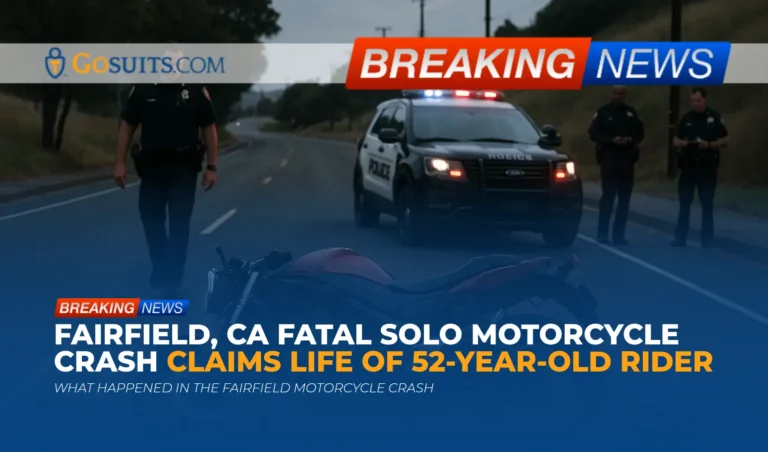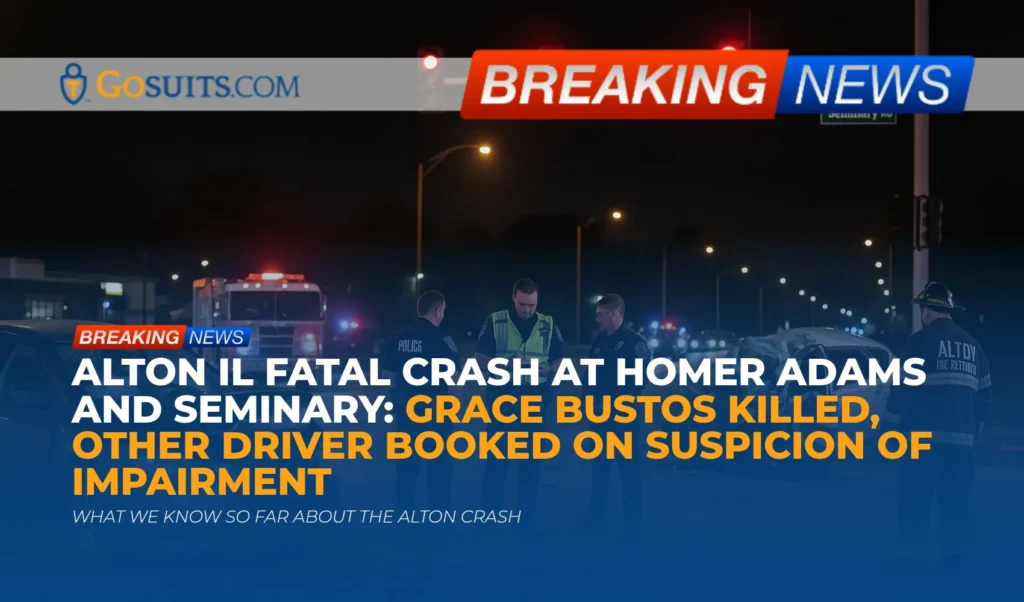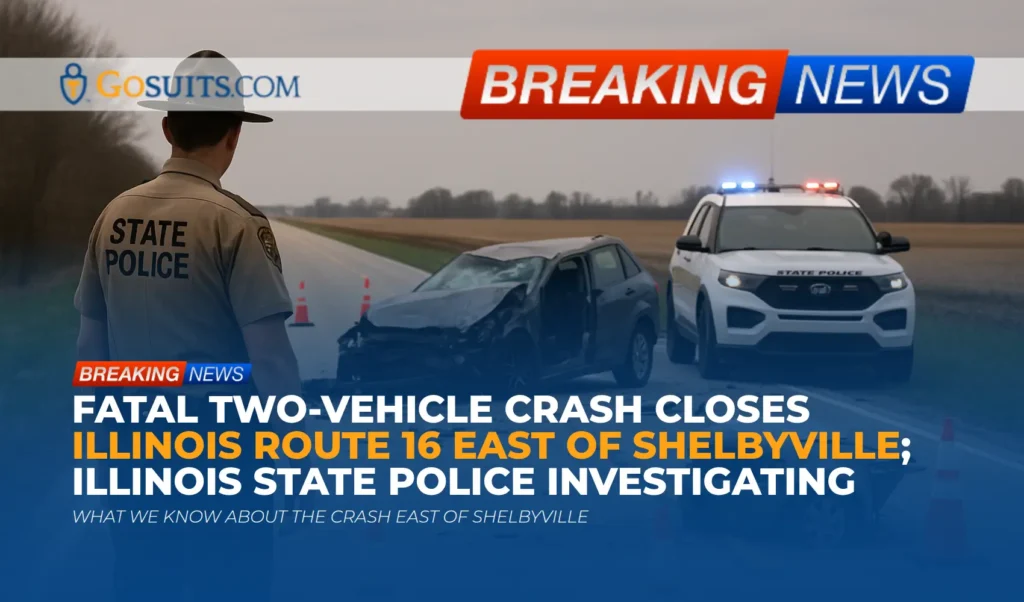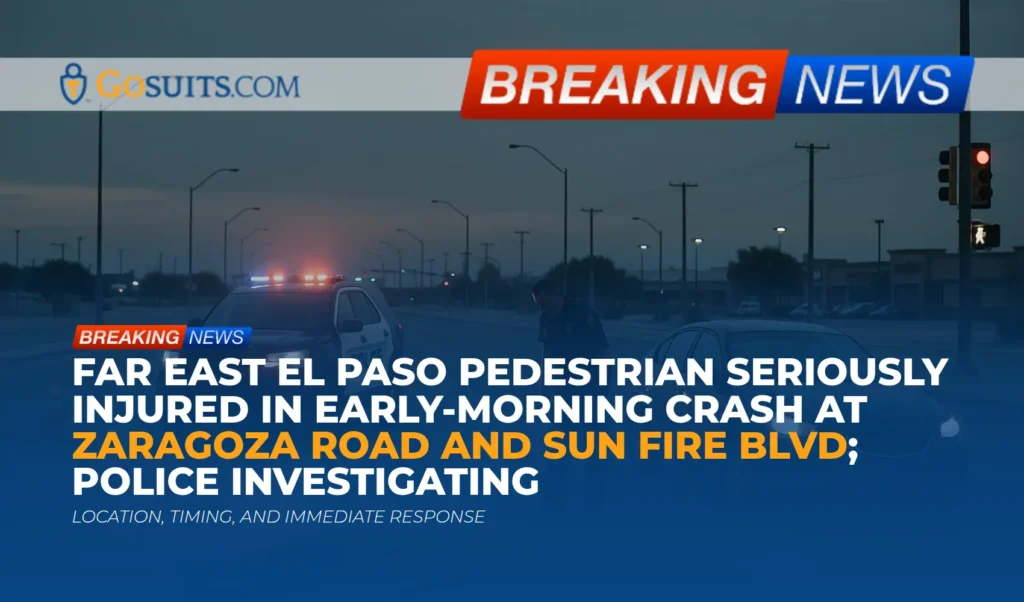- What Happened in the Fairfield Motorcycle Crash
- Immediate Steps Families May Consider
- How to Obtain Official Records and Information
- Understanding Possible Civil Liability in a Solo Motorcycle Crash
- Preserving Evidence and Documenting Losses
- Insurance Considerations in California After a Fatal Motorcycle Crash
- Time Limits and Key California Laws
- Safety Context, Roadway Factors, and Motorcyclist Risk
- Support and Crisis Resources
- Commentary from Gosuits Fairfield, California Personal Injury Attorney
- Important Next Steps and Why Timing Matters
What Happened in the Fairfield Motorcycle Crash
Fairfield police reported that a motorcyclist was involved in a solo crash near Noonan and Cement Hill Road in Fairfield on Friday evening. Calls began coming in at around 6:45 p.m. Officers arrived to find the rider with severe injuries. He was transported to a hospital, where he was later pronounced deceased. Authorities described the rider as a 52-year-old man. His name will be released after next-of-kin notification.
At the time this information was shared by law enforcement, there were no public details about contributing factors such as traffic conditions, roadway defects, weather, or mechanical issues. In the early phases of any investigation, facts can remain limited as police work to document the scene, identify and interview witnesses, and secure any available video or data. Families should know that even when an initial report references a solo crash, further investigation can uncover additional factors that help explain what happened.
Immediate Steps Families May Consider
If a loved one was involved in this incident, the period that follows is overwhelming and painful. The points below are offered to help orient families to practical steps that often arise during the first days and weeks. Every situation is different, and nothing here is meant to be a directive. Take the steps that feel appropriate for your family and circumstances.
- Identify the investigating agency and the incident number. In this crash, Fairfield Police Department responded. Ask for the report or incident number, the officer’s name, and the Records Unit contact information. This will make later requests easier.
- Note where your loved one was transported. If your loved one was taken to a hospital, write down the facility name. Hospital medical records may be relevant for insurance, benefits, and later reviews of what occurred.
- Preserve relevant information. Save any photos, dashcam footage, helmet cam footage, ride-tracking app data, or texts that could relate to the time and location of the crash. Preserve your loved one’s motorcycle, helmet, clothing, and gear in their post-incident condition if possible.
- Identify possible witnesses. If anyone contacted you who was present at or near the crash scene, note their names, phone numbers, and any details they shared.
- Be cautious with insurance communications. Before giving recorded statements to any insurance carrier, consider consulting an attorney. What is said to insurance representatives can be used later to limit a claim. A free consultation can help clarify rights and options before you speak with insurers.
- Support and care. Grief is a heavy burden. Consider reaching out to trusted community, faith, and mental health resources for support. A national helpline is listed below in the Support and Crisis Resources section.
How to Obtain Official Records and Information
Following a fatal crash, several different records may exist. These can be important for understanding what happened, for benefits, and for insurance. Processes vary by agency, but the guidance below will help you get started.
Police Traffic Collision Report
Because Fairfield Police responded, the primary report is likely a Fairfield Police Department traffic collision report. Parties of interest, such as the decedent’s legal next of kin, estate representative, or an attorney representing the family, can typically request a copy of the report once it is approved for release. California law limits the disclosure of certain collision reports to involved parties, insurers, and legal representatives.
- Where to request: Fairfield Police Department Records Unit, accessible through the City of Fairfield’s official website at fairfield.ca.gov. Look for Police Department and Records or Report Request information.
- What to have ready: Report or incident number if available, date and location of the crash, your relationship to the decedent, and government-issued identification. There may be a processing fee.
- Alternate agency: If the California Highway Patrol (CHP) had primary jurisdiction for a crash, collision reports are requested using CHP procedures. See the CHP’s public guidance on obtaining reports here: chp.ca.gov. CHP’s process typically uses a form to verify involvement before release.
- Legal framework: California Vehicle Code section 20012 governs the confidentiality and authorized disclosure of traffic collision reports to parties in interest. See the statutory text at the California Legislative Information site: leginfo.legislature.ca.gov.
Coroner and Autopsy Information
Fatal collisions in Fairfield are typically handled by the county coroner’s office. The coroner’s role is to determine cause and manner of death and to manage next-of-kin notifications. Autopsy reports and related records may be disclosable to next of kin, though certain materials and photographs can be restricted. Availability can vary by county and by the status of any ongoing investigation.
- Where to inquire: Solano County Sheriff’s Office Coroner Unit. To locate current contact details, visit the Solano County government website and navigate to Sheriff or Coroner services.
- What to have ready: The decedent’s full name, date of death, location of incident, and your relationship to the decedent.
- Public records framework: The California Public Records Act governs access to government records and contains exemptions for specific sensitive materials. A general overview is provided by the California Attorney General at oag.ca.gov.
Death Certificates
A certified death certificate is often needed for benefits, banking, insurance, and estate matters. Certificates are issued at the county or through the California Department of Public Health.
- Where to request: The California Department of Public Health, Vital Records. Guidance for requesting certificates is available at cdph.ca.gov. Families can also request through the county recorder’s office where the death occurred.
- What to have ready: Government-issued identification, completed application, and any documentation required to prove entitlement to receive a certified copy.
911 Audio, Dispatch Logs, and Body-Worn Camera
Some families seek 911 recordings, dispatch logs, or officer body-worn camera footage to better understand the timeline. Availability and timing of release are subject to California law and agency policies, especially when an investigation is active. The California Public Records Act may apply, but there are exemptions. You can submit a written request to the Fairfield Police Department, describing the records sought and your relationship to the incident. If the request is denied or delayed due to an ongoing investigation, the agency typically explains the basis and timeline.
Understanding Possible Civil Liability in a Solo Motorcycle Crash
When initial reports describe a solo motorcycle crash, it is natural to wonder whether anyone else can be held civilly responsible. The answer depends on facts that an investigation can uncover. Below are common categories that can affect liability in a single-vehicle motorcycle crash:
- Roadway conditions and maintenance: Hazardous road defects can contribute to loss of control. Examples include potholes, uneven pavement, dangerous edge drop-offs, loose gravel, inadequate signage, malfunctioning signals, and obscured sight lines. Claims based on roadway design or maintenance typically involve a public entity and have special notice requirements and deadlines.
- Visibility and traffic control: Missing or obscured warning signs, inadequate lighting, or temporary construction zones without proper control measures can increase risk. Documentation of the scene as it existed at the time is important.
- Vehicle or component defects: Tire failure, brake issues, or other mechanical defects can contribute. If a product defect is suspected, preserving the motorcycle and the specific part is crucial for evaluation.
- Third-party actions without contact: Even without physical contact, another driver can cause or contribute to a motorcycle crash by cutting off a motorcyclist, dropping debris, or making unsafe maneuvers that force evasive action. Witness statements and nearby video often become essential when this is a possibility.
- Uninsured or unidentified vehicles: A hit-and-run or phantom vehicle can be implicated if evidence shows interference or debris from another vehicle. Insurance policies may address this scenario in specific ways, discussed below.
In wrongful death cases, California allows certain family members to bring a civil action to recover legally recognized losses. It is essential to first understand the facts, preserve evidence, and consider an early consultation so that deadlines and available claims are not missed.

Preserving Evidence and Documenting Losses
Evidence does not last long after a crash, and memories fade quickly. Steps that help protect the integrity of a potential claim include:
- Secure the motorcycle and gear: Do not repair or dispose of the motorcycle, helmet, jacket, and boots before an independent inspection. These items can reveal contact marks, failure points, or evidence of roadway defects.
- Photograph the scene and surroundings: If possible, capture images or video of the roadway surface, traffic controls, skid marks, gouge marks, debris, lighting, and any temporary construction in the area of Noonan and Cement Hill Road.
- Identify and contact witnesses: Neutral witnesses can help establish key facts. Record full names, contact details, and a brief summary of what each person observed.
- Locate video sources: Ask nearby residences or businesses for exterior video. Many systems overwrite footage within days. Traffic or intersection cameras, if present, may be controlled by the city or county.
- Preserve digital data: Save ride-tracking app data, smartwatch records, and mobile phone location data. If your loved one used a helmet camera, secure the device and any memory cards.
- Keep a timeline and journal: Write down what you learn and when, including communications with agencies and insurers. Documentation helps avoid gaps and reduces stress later.
Insurance Considerations in California After a Fatal Motorcycle Crash
Insurance issues are complex after a fatal crash and can have long-term financial implications for a family. It is often wise to consult an attorney before formal communications with insurers, and certainly before providing recorded statements. What is said to an insurer can be used to limit or deny claims later.
- Bodily injury liability of another driver: If evidence shows another motorist contributed to the crash, that driver’s liability coverage may be implicated. Even without physical contact, negligent maneuvers can cause a crash. Proof can come from witnesses, vehicle data, or video.
- Uninsured or underinsured motorist coverage: Many motorcycle policies include UM or UIM coverage. These benefits can apply if an at-fault driver lacks adequate insurance. For crashes involving a phantom vehicle, policies often require some corroborating evidence. Policy language varies, and deadlines to notify the insurer can be strict.
- Medical payments coverage: Some motorcycle policies offer medical payments coverage. This can provide limited benefits regardless of fault, although policy exclusions can apply.
- Roadway defect claims and public entities: If a roadway hazard contributed, claims against a city, county, or state agency follow specific procedures under California’s Government Claims Act, which requires timely written notice well before any lawsuit. See the legal deadlines cited below.
- Life insurance and employer benefits: Families often overlook employer-provided life insurance, accidental death benefits, pension or survivor benefits, and union benefits. Request plan documents and claim forms early.
Insurance carriers regularly request medical records, prior claims histories, and recorded statements. Consider seeking a free consultation before responding. A consultation can help clarify what must be provided, what can be reserved until needed, and how to avoid statements that might later be misunderstood.
Time Limits and Key California Laws
California has strict time limits that can affect a family’s ability to pursue civil claims. These deadlines are not flexible in most cases, so it is critical to understand and calendar them early. The citations below are provided for educational purposes using official California government resources.
- General wrongful death statute of limitations: In most cases, a wrongful death action must be filed within two years of the date of death, under California Code of Civil Procedure section 335.1. Text available at the California Legislative Information site: leginfo.legislature.ca.gov.
- Survival actions: A decedent’s estate may bring a survival action for certain losses the decedent suffered before death. See Code of Civil Procedure section 377.30 at leginfo.legislature.ca.gov.
- Who may bring a wrongful death claim: California Code of Civil Procedure section 377.60 identifies the individuals who may bring a wrongful death claim, including certain family members and dependents. See the statutory text at leginfo.legislature.ca.gov.
- Claims against public entities: If a claim involves a city, county, or state agency, written notice must generally be presented within six months for claims involving injury or death, per Government Code section 911.2. See the statute at leginfo.legislature.ca.gov.
- Motorcycle helmet law: California requires compliant helmets for riders and passengers, under Vehicle Code section 27803. See the statutory text at leginfo.legislature.ca.gov. Helmet compliance can be discussed in civil cases, but the absence or presence of a helmet does not automatically determine liability.
- Collision report access: Vehicle Code section 20012 addresses confidentiality and access to traffic collision reports by parties of interest. See leginfo.legislature.ca.gov.
Time limits can be shorter in specific circumstances, such as when a government claim must be presented first or when a potential defendant is unknown. Early evaluation helps avoid missing a critical deadline.
Safety Context, Roadway Factors, and Motorcyclist Risk
Motorcyclists face unique risks on the road due to visibility, stability, and the lack of a protective vehicle frame. Understanding the broader safety context does not diminish the individuality of any one crash, but it can help families make sense of the issues investigators consider.
- Motorcycle vulnerability: NHTSA highlights that motorcycles offer less protection than passenger vehicles and are more sensitive to roadway surface problems. See NHTSA’s motorcycle safety information at nhtsa.gov/road-safety/motorcycles.
- Roadway design and maintenance: Federal Highway Administration guidance emphasizes that pavement condition, surface friction, and edge drop-offs can be important safety considerations, particularly for two-wheeled vehicles. For general roadway safety programs, see the U.S. Department of Transportation’s Federal Highway Administration resources at safety.fhwa.dot.gov.
- California crash and safety initiatives: The California Office of Traffic Safety provides data and programs focused on reducing roadway fatalities, including motorcycle crashes. See ots.ca.gov.
Investigations often consider whether any roadway feature or temporary condition could have contributed, including loose debris, a fresh chip seal, a raised manhole cover, or abrupt changes in pavement. Lighting, signage, and lane markings are also evaluated. If a hazard is identified, it is critical to document it promptly and to follow statutory claim procedures for public entities.
Support and Crisis Resources
There is no right way to grieve and no set timeline. Support from loved ones and community can be essential. If the emotional strain feels overwhelming or if someone is in crisis, confidential help is available 24 hours a day.
- SAMHSA National Helpline: 1-800-662-HELP. A free and confidential treatment referral and information service. Learn more at samhsa.gov/find-help/national-helpline.
- Local resources: Many counties offer victim services or crisis response teams that can provide information about counseling, victim compensation, and practical support. Check your county’s official website for details.
Commentary from Gosuits Fairfield, California Personal Injury Attorney
Our hearts go out to the family and loved ones of the rider who lost his life near Noonan and Cement Hill Road. This article is intended for education and general information. In our work with families after serious crashes, we see the weight of grief and the confusion that follows when answers are not yet clear. Compassion and patience from agencies and the community matter in these moments.
From a civil law perspective, even when a crash is initially described as solo, a careful review can reveal issues with roadway conditions, sight lines, temporary construction, defective components, or the actions of another motorist who may not have made contact. It is important not to assume fault without a thorough look at the evidence. Prompt evidence preservation, respectful communication with investigators, and early review of available records can help families understand what happened and what options may exist under California law.
Insurance companies and large corporations are practiced at handling claims every day. They often act quickly to obtain statements, limit disclosures, and shape the record. People living through a loss are focused on loved ones and may not know what information must be provided and what can wait. Policy terms, exclusions, and notice requirements can be hard to navigate without context, and statements given early can be used later to reduce or deny benefits. A free consultation offers a practical way to understand rights and duties before engaging with insurers, so decisions are informed rather than rushed.
If your family is considering next steps, a no-cost conversation with a seasoned, skilled injury attorney can help you understand timelines, potential claims, and what to preserve now so that important details are not lost.

Important Next Steps and Why Timing Matters
The period after a fatal crash is overwhelming. When it feels appropriate to take action, the items below explain what to do and why timeliness can protect important rights and information.
- Secure the official records: Request the Fairfield Police collision report number and confirm when the report will be available. Ask the coroner’s office about the status of the investigation, cause and manner of death, and how to request the autopsy report. Obtain certified death certificates from the county or the California Department of Public Health. Acting early helps avoid delays that can affect benefits and insurance claims.
- Preserve the motorcycle and safety gear: Do not repair, sell, or dispose of the motorcycle, helmet, or clothing. These items may hold critical evidence. Preservation is time-sensitive because tow yards and insurers may move or alter items as part of their processes.
- Collect visual evidence: Photograph the crash area at or near the same time of day the collision occurred. Lighting and traffic patterns can change quickly. Try to capture pavement condition, markings, signage, and any construction or debris. Visual records are often most valuable when captured soon after the event.
- Locate witnesses and video: Ask nearby homes and businesses about external cameras and preserve any footage. Many systems overwrite within days. Witness memories fade quickly, so recording statements early improves accuracy.
- Review insurance policies carefully: Locate motorcycle insurance, any personal umbrella policy, and relevant household policies. Identify UM or UIM benefits and medical payments coverage. Policies often have prompt notice requirements. Before calling insurers, consult with an attorney about what to say and what documents to share. Statements to insurers can be used to minimize claims later.
- Calendar legal deadlines: In California, most wrongful death claims must be filed within two years of the date of death, and claims against public entities often require a written claim within six months. Early assessment ensures compliance with these timelines and prevents forfeiture of rights.
- Document economic and non-economic harms: Begin compiling records of funeral and burial expenses, medical records from the hospital, employment records, and any benefits impacted by the loss. Early documentation makes it easier to present a complete and accurate picture when it matters.
- Seek a free legal consultation: A no-cost consultation provides clarity on rights and steps, including how to approach insurers and agencies. It can prevent missteps such as making recorded statements or signing releases before understanding the implications.
Taking these steps promptly can preserve crucial information, reduce stress later, and help protect the rights allowed under California law. Acting now matters because evidence, video, and memories are at their strongest in the first days and weeks, and because statutory deadlines can shorten options if they are missed.
Government and Educational Resources Cited
- National Highway Traffic Safety Administration: Motorcycles
- Federal Highway Administration: Roadway Safety
- California Office of Traffic Safety
- California Legislative Information: Vehicle Code, Government Code, and Code of Civil Procedure
- California Department of Public Health: Vital Records
- California Attorney General: Public Records Act Overview
- City of Fairfield
- California Highway Patrol: Collision Reports
- SAMHSA National Helpline






